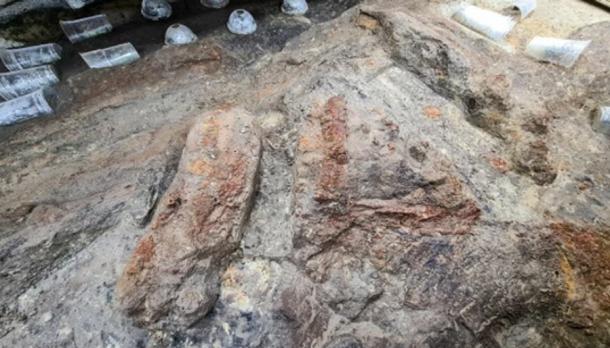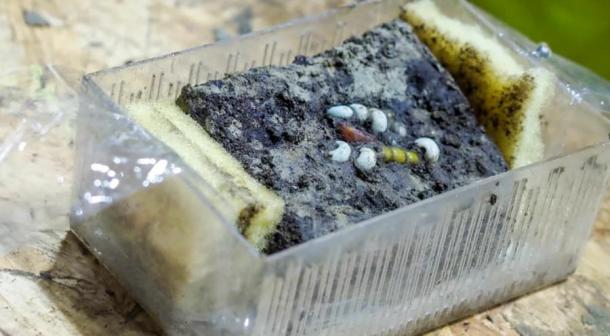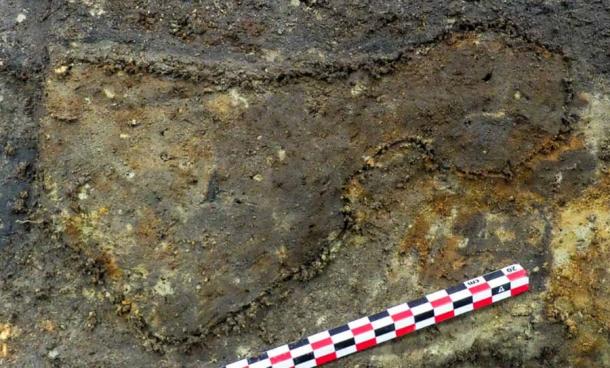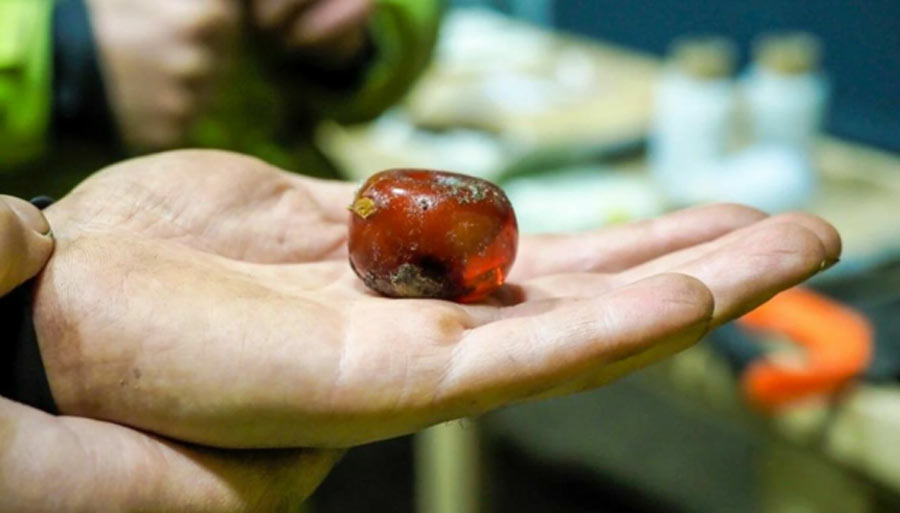Most Exciting Finds From The Gjellestad Viking Ship So Far
It was in the May of 2020 when a 1,000-year-old Viking ship burial site, the Gjellestad Viking ship, was planned for extensive excavations. The site was discovered in 2018 and since then Ancient Origins has reported on the fragility of the site and how extended exposure to the elements could harm the site.
So far, the Gjellestad Viking ship burial site excavations have been a grand success. Important finds include a huge amber bead (pictured above), many horse teeth, and countless wood fragments from the Viking ship long buried in the ground, reports Science Norway. A number of impressively built Viking longhouses have also been discovered just north of where the ship was buried.
The Gjellestad Viking ship excavation is the first monumental Viking ship burial in Norway in the last hundred years. Wood doesn’t last very long underground and the Gjellestad Viking ship was mostly a nail outline and lots of wood fragments.
“We don’t have a full overview of what we’ve actually found, there might still be some surprises here,” said archaeologist Christian Løchsen Rødsrud, project manager of the Gjellestad excavations. Her team brought the unearthed artifacts in the soil they were found in to the Museum of Cultural History in Oslo for further analysis.

The Gjellestad Viking ship researchers think this is a deteriorated Viking chest. (Museum of Cultural History, Oslo)
Gjellestad Viking Ship Artifacts: Metal, Beads, and Axes
So far the Gjellestad Viking ship burial excavations have produced a whopping 8,000 pieces of iron and copper alloy artifacts, leaving scientists with the uphill task of reconstructing and reimagining their usage. There is also the added burden of knowing that grave robbers may have stolen key items from the site that could tell researchers more.
- Grave Findings Could Solve a Viking Age Mystery
- Researchers Wonder if Rich Viking Boat Burial Found in Scotland was Made for a Warrior Woman
According to Rødsrud, the very large amber bead was an amazing and important find. It is unusually large, with a hole big enough to allow a cord or chain to pass through it. It was perhaps a sword bead, common in pre-Viking times and attached to the sheath of the sword. It may have been placed in the burial as a form of protection from the dangers that lurk in the afterlife.
Another soil block produced a tiny collection of smaller beads: six white, one amber, and three segmented, probably part of a Viking necklace or bracelet.

A block of soil containing beads found at the Gjellestad Viking ship site in Norway. (Museum of Cultural History, Oslo)
Two Viking axes were also found at the site. One was the enormous imprint of a Viking axe, which was probably removed by grave robbers. The second axe, a corroded lump of rust, was found underneath the ship.
The placement of the second axe under the ship burial is puzzling but the researchers have possible answers. Either the axe was used as a wedge lock the ship in place, or it was left there as a ritualistic artifact commemorating the death of a Viking elite. It could have also been a part of the burial ceremony. It is also possible that grave robbers left the axe behind after trying to use it to dislodge the ship.

The imprint of an unusually large Viking axe head found at the Norwegian. (Museum of Cultural History, Oslo)
Animal and Human Remains: Ritual Sacrifice?
The horse teeth found at the site, 25 of them, along with 560 bone fragments from hoofed animals suggest that they were sacrificed for the ship burial. Human bones were also discovered at the site, which could be either from a secondary burial, or someone buried at the site much later. Radiocarbon dating will quickly provide answers to these question.
A weapons’ sharpening stone or whetstone was also found at the site. These sharpening stones were an essential part of a warrior’s kit to hone the blades of their knives and swords. Whetstones were also a popularly traded commodity in the Viking era.
The Gjellestad Viking ship burial excavations also yielded 1,300 ship nails and pieces of the vessel’s keel (9 meters or 29.5 feet in total length). Another keel section was 6 meters (19.6 feet) long.
Finally, unlike other Viking ships, the Gjellestad ship was not made from oak but coniferous wood, as suggested by the reddish tinge of the wood.

Plastic cups have been used to protect and preserve all the ship nails, which form an outline of the ship, before excavation with a new rivet-extracting-invention. (Museum of Cultural History, Oslo)
Viking Ship Burials and Seeing Gjellestad as an Iron Age Powerhouse
The Gjellestad Viking ship burial discovery of 2018-19 is outstanding as it relied on the emerging field of digital archaeology. For example, technologies like motorized high-resolution geo-radar devices are inexpensive enough for archaeologists now.
The ship’s discovery in the digital archaeology era is viewed differently and from a wider perspective. Now we are learning to see how Gjellestad emerged as a regional Iron Age Viking powerhouse. The five longhouses found just north of the ship burial are especially illuminating. One of these was 60 m (197 feet) long and 15 m (49 feet) wide, the largest longhouse ever found in Scandinavia, reports Sci-News.
- Puzzling Medieval Runes Found on Stone in Norway
- Archaeologists Prove That Vikings Rode ‘Stallions’ Rather Than Mares, Especially into The Afterlife
“Finding these longhouses confirms that Gjellestad was a central place in the late Iron Age. Our hope is that within the next years, we will understand the relationship between the ship, the buildings and the rise of central places much better,” said NIKU (Norwegian Institute for Cultural Heritage Research) archaeologist Lars Gustavsen.
The Vikings were renowned for their elaborate and complex ship burials, burying a king or a queen in this grand manner, to prepare them for the afterlife. The scope of this find is part of the ambitious “ Viking Nativity: Gjellestad Across Borders” project (2021-25). The finds so far have been documented meticulously here and here by NIKU.
Top image: An unusually large amber bead is the “apple-of-our-eye” find from the Gjellestad Viking ship excavation, according to archaeologist and project manager Christian Løchsen Rødsrud. Source: Museum of Cultural History, Oslo
By Sahir Pandey
References
Bergstrom, I.I. 2021. The 12 most exciting finds from the Gjellestad Viking ship dig. Available at: https://sciencenorway.no/archaeology-history-iron-age/the-12-most-exciting-finds-from-the-gjellestad-viking-ship-dig/1948461.
Sci-News. 2022. Archaeologists Find Five Viking Longhouses in Norway. Available at: http://www.sci-news.com/archaeology/gjellestad-longhouses-10427.html.



















